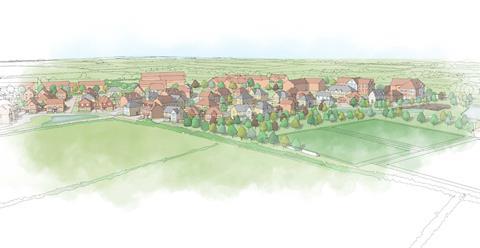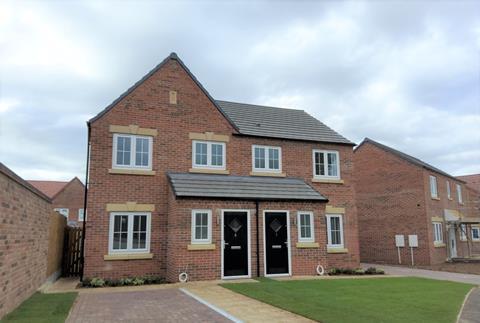Housing associations have stopped bidding to buy section 106 homes in many parts of the country, resulting in a drop-off in affordable homes and major delays on for-sale schemes. Joey Gardiner asks what the implications are and how the problem can be resolved

For 100-homes a-year Kent housebuilder Fernham Homes, the permission secured at Love Lane in Faversham last summer to build 154 houses should have been a significant boost. One year on, however, and managing director Sean Ellis says the firm has not had one viable bid for the 54 affordable homes on the site.
The scheme has been out to a host of housing associations in an attempt to find a buyer, but building work still cannot start. In fact, only one of the 20 registered providers approached to take on the homes put in any bid at all, which Ellis says was at a level ŌĆ£well below what we had been prepared to acceptŌĆØ.
This was not a unique experience. Ellis says the same thing is happening around so-called section 106 affordable homes on every scheme he is bringing forward. ŌĆ£ItŌĆÖs every site at the moment. This is one of the most critical issues we face,ŌĆØ the former Berkeley Group director says.
EllisŌĆÖs experience appears to be part of a wider issue across the development sector, consequent of the precipitous drop in new housing association development output in the last 18 months.

As registered providers (RPs) have drawn in their horns, the first casualty appears to have been the homes they buy off private developers built under planning agreements with local authorities. In the past couple of months both Barratt and Taylor Wimpey have sounded the alarm on this issue in different ways, making clear that it has the potential not just to hold up delivery of affordable housing, but of housebuilding of all types.
So, how bad is this problem? And what does it all mean for a government which has promised to deliver not only the biggest boost to social and affordable housing in a generation, but also 1.5 million new homes of all kinds by the end of this parliament?
Fundamental
Section 106 deals are agreements between developers and local planning authorities which commonly oblige developers, as part of the grant of a planning permission, to set aside a proportion of the site for affordable housing. They have become an increasingly important mechanism for funding and providing new affordable homes.
Official government figures show that, in the year to March 2023 (the latest for which data are available), 47% of all affordable homes completed came this way ŌĆō just over 30,000 homes.
However, the same official figures for affordable housing show that, when you look at starts rather than completions, even up to March 2023, section 106 appears to be losing traction. Just 30% of starts (21,193) in that year came from section 106 ŌĆō which compares to a high of 55% as recently as five years previously.
It isnŌĆÖt all RPs, but it is the majority. New development is being squeezed out.
Gareth Turner, director of development viability at consultant Savills
Since then, anecdotally, the situation appears to have worsened, and Gareth Turner, director of development viability at consultant Savills, which has recently surveyed RPs on the subject, says it is a ŌĆ£huge issueŌĆØ in the market. His survey found that more than half of RPs are either no longer purchasing any section 106 homes, or are reducing their purchasing, with three-quarters saying their current financial capacity had affected their appetite to buy houses.
ŌĆ£It isnŌĆÖt all RPs, but it is the majority. New development is being squeezed out,ŌĆØ Turner says. ŌĆ£This is a fundamental problem.ŌĆØ
Syreeta Robinson-Gayle, head of affordable housing at Barratt London, recently told a committee at the Greater London Assembly that the system was ŌĆ£creaking at the seamsŌĆØ, with section 106 acting as a ŌĆ£collar on developmentŌĆØ. ŌĆ£If we are not very careful that we will have lots of homes that are getting towards completion without RPs to take them,ŌĆØ she said.
Taylor Wimpey told investors at its half year that the issue was so severe that ŌĆ£lack of funding for housing associations has the potential to impact sector order books and the overall delivery of affordable housing in coming yearsŌĆØ.
The widespread view is that section 106 purchases are bearing the brunt of the financial crunch pressing on much of the housing association sector, with the median ŌĆ£interest coverŌĆØ held by the sector ŌĆō a measure of financial capacity ŌĆō dropping to just 128% earlier this year, its weakest level since 2010.
Maggie Rafalowicz, a director at housing consultant Campbell Tickell, says RPs were facing a ŌĆ£perfect stormŌĆØ given regulatory pressures to divert money to existing stock, plus soaring inflation and capped rents. She says the problem of developers not being able to find housing associations to bid on S106 deals is a reality in around three-quarters of the local authority areas she works in. ŌĆ£This is a problem up and down the country,ŌĆØ she adds.
Baby steps
The experience of one small housing association, Leeds Federated Housing Association (LFHA), provides a good example. Despite only owning around 4,000 homes, this organisation has a corporate plan to build 150 homes per year, with a development programme that had traditionally been dominated two-thirds by S106 purchases, and then supplemented by homes from its own sites.

The spring of 2022 saw it take on 146 homes from Persimmon, for example. However, Philip Hayton, new business manager at the RP, says that, in the wake of Liz TrussŌĆÖs mini-Budget, the organisationŌĆÖs finance director immediately made the decision to pull out of some ŌĆ£bread and butterŌĆØ section 106 deals just days before completion. He wanted to prioritise financial stability.
Since then, the association has put through just one new section 106 deal, for just six homes, and its development programme is now dominated by its own land-led schemes. ŌĆ£Since then, weŌĆÖve been building back,ŌĆØ Hayton says, ŌĆ£but itŌĆÖs baby steps ŌĆō there wonŌĆÖt be enough in the pipeline to keep building at the level we have been.ŌĆØ
A survey of its members by the Home Builders Federation, conducted in February this year, found evidence of 13,000 consented homes without housing association purchasers, many of which were scheduled to be built this year. Given that the respondents represented just a third of the market, the HBF estimated from this that around a quarter of section 106 delivery is currently endangered.
Development stops
What particularly concerns developers is the impact on private development. Anthony Lee, head of UK development viability at consultant BNP Paribas, says that section 106 deals are typically structured so that legally a developer is not allowed to build beyond a certain number of homes before the affordable element is delivered.
If you canŌĆÖt get interest from an RP, then it might mean you canŌĆÖt pick tools up, or that development stops
Anthony Lee, head of UK development viability at consultant BNP Paribas
More than that, however, many developers rely on the cash from an affordable sale to an RP to start on site in the first place. ŌĆ£Normally the RP sale effectively pays the cost of construction,ŌĆØ Lee says, adding that single phase blocks are particularly hamstrung by this issue. Lee estimates that about a third of developments are currently hitting this hurdle.
ŌĆ£No one is going to start a block on this basis [of no affordable sale],ŌĆØ he says. ŌĆ£If you canŌĆÖt get interest from an RP, then it might mean you canŌĆÖt pick tools up, or that development stops.ŌĆØ
Leeds FederatedŌĆÖs Hayton says: ŌĆ£I think housebuilders think that associations are just going to keep on coming over the hill with wheelbarrows of cash and de-risk their projects. I donŌĆÖt know if thatŌĆÖs going to work.ŌĆØ
David OŌĆÖLeary, executive director at the HBF, says the issue is now holding up the delivery of ŌĆ£tens of thousandsŌĆØ of new homes of all tenures. ŌĆ£The dearth of interested parties means that smaller sites are not starting at all and delivery on larger sites is slowing or stoppingŌĆØ, he says.
Typically, where no buyer can be found, developers ultimately go back to the local authority to try to change their obligations under the section 106 agreement ŌĆō something that takes significant negotiation and a lot of time (see box), holding up progress.
Depleted
While the issue does seem to be live across the country, commentators suggest that it is most acute in London and the South-east. Figures seen by Housing Today from the G15 group of the largest London-based RPs appear to back this.
They show that the total number of affordable starts on site dropped by two-thirds between the 2020/21 and 2023/24 financial years, to 2,031. However, for S106 schemes, the situation is worse still: starts dropped 76% to just 549.
Paul Hackett, chief executive of G15 landlord Southern Housing, says: ŌĆ£Housing association capacity is more depleted now than at any time since the 1980s. Most of the G15 have a cash interest cover below 100%.
ŌĆ£This is especially problematic as London and the South-east have the greatest affordability gap and the greatest shortfall of social housing. Housing associations in the areas of the country with the greatest need have the least capacity.ŌĆØ
The section 106 problem is particularly bad for small schemes, as the G15 data also show. They show that on projects of under 100 units, S106 starts were in 2023/24 just 13% of the level they were in 2020/21.

SavillsŌĆÖ Turner says this is because smaller schemes can result in higher management costs for associations, while Peabody executive director Angela Wood, chair of the G15 development directors group, says smaller schemes have similar transaction and legal costs to larger ones but for less output ŌĆō making them less desirable.
Reality check
For some, however, the situation is not perhaps quite as straightforward as is being portrayed by developers. If the case made by some developers and consultants is simply that many associations have left the market and wonŌĆÖt bid on schemes at all, others point to longer-term concerns over the S106 system and say housebuilders have been slow to react to a changing market.
Ben Denton, chief executive of ŌĆ£for profitŌĆØ RP L&G Affordable Homes, says: ŌĆ£IŌĆÖm not convinced thereŌĆÖs no bidders for section 106 homes. I think the reality is developers would like rather more price competition among housing associations for the affordable units. They are now having to decide whether or not to accept a lower price than they are used to.ŌĆØ
Helen Fielding, development and investment director at 7,000-home Broadacres Housing Association based in rural north Yorkshire, says her organisation is still bidding on section 106 schemes, but whereas last year it was being outbid by ┬Ż20,000 to ┬Ż30,000 a unit in a hot market, ŌĆ£now demand has dried upŌĆØ.
She adds: ŌĆ£People were bidding silly money.ŌĆØ
Following Grenfell and scandals over the state of upkeep of some housing association homes, Anna Clarke, director of policy and public affairs at industry group the Housing Forum, makes the case that housing associations are also just being a lot ŌĆ£choosierŌĆØ about the stock that they take on, particularly around not taking homes with gas boilers, that will have to be retrofitted in a few years, or small bedrooms.
RPs have always had concerns about the lack of control over quality and specifications that taking on S106 stock allows, and Marie Chadwick, policy leader at housing association trade body the National Housing Federation, says this is now ŌĆ£really front of mind, driving decision-makingŌĆØ.
What happens when no buyers are found?
Developers who fail to find housing association buyers for the affordable portions of their schemes are resorting to a raft of alternative strategies to get schemes underway, according to those involved in the process. The most common option is to return to the local authority and request to renegotiate the section 106 agreement.
Planning authorities have no obligation to enter into negotiations until five years have elapsed, but developers will make the case that, unless changes are made, no homes will be built. Consultants say that developers commonly first ask for permission to change the requested tenure of homes, with shared ownership houses easier to find buyers for, before ultimately proposing a payment in lieu to the council if that still fails to secure a buyer.
BNP Anthony ParibasŌĆÖ Lee says: ŌĆ£Councils donŌĆÖt have to renegotiate but, for those that want to see homes, theyŌĆÖre left with little choice.ŌĆØ
The NHFŌĆÖs Marie Chadwick says talk in the market about ŌĆ£payments in lieuŌĆØ instead of delivering affordable housing ŌĆ£rings alarm bellsŌĆØ. She adds: ŌĆ£We need affordable homes provided on site ŌĆō something has to be done now before this becomes a crisis.ŌĆØ
Developers are now looking to head off this problem in advance by inserting ŌĆ£cascade provisionsŌĆØ into S106 agreements. These set out a process which allows developers to move to alternative tenures and ultimately a payment in lieu, and which is automatically triggered where no buyers for affordable homes can be found.
The idea is that this saves the time spent in lengthy bespoke negotiations later on. However, Nicola Gooch, partner at law firm Irwin Mitchell, says cascades themselves are complicated to draft, take time and have the potential to hold up agreements.
The Housing ForumŌĆÖs Anna Clarke says councils should think seriously about the implications of allowing cascades, and whether developers might simply just start to assume they can get out of affordable obligations.

The other way that developers are solving the current problem is by offering housing associations more affordable homes than specified in the section 106 agreement ŌĆō known in the jargon as ŌĆ£additionalityŌĆØ ŌĆō which they can then attract grant to. This can therefore count to the RPŌĆÖs committed programme with either Homes England or the GLA.
VistryŌĆÖs Teagle says this is what his firm commonly does, with about 50% of its schemes usually affordable. FernhamŌĆÖs Ellis says this was the solution on a project of his in Fawkham.
ŌĆ£ItŌĆÖs the only way that we seem to be able to get our schemes to work,ŌĆØ Ellis says, adding that most councils ŌĆ£arenŌĆÖt interestedŌĆØ in payments in lieu.
In order to assuage these concerns, Chadwick, Fielding and others urge developers to engage with housing associations early, allowing them to input into the specification process, in order to maximise their chances of securing a sale. For example, Stephen Teagle, chief executive of Vistry Partnerships, says VistryŌĆÖs business model is to engage with associations earlier in the process ŌĆō and he has not as yet experienced a widespread failure to secure RP buyers.
BroadacresŌĆÖ Field says: ŌĆ£Often what weŌĆÖre offered is not at the quality we would expect. But we work proactively to persuade developers to provide the house types we need, and do get some success, usually with SMEs. They are now a lot more willing to have discussions.ŌĆØ
Solutions
But, while it could be argued that developers could be doing more to help themselves, it seems unarguable that there is reduced appetite for section 106 from RPs. While some in the sector argue that grant funding should be again given to S106 homes (as it used to be), the Housing ForumŌĆÖs Anna Clarke argues this could be a ŌĆ£slippery slopeŌĆØ unless very clearly time limited, as it would simply feed in to high land values.
The NHFŌĆÖs Chadwick is in discussions with Homes England about setting up a public ŌĆ£clearing houseŌĆØ in which section 106 sale opportunities could be publicised, in order to give developers the best chance of securing buyers.

However, many in the sector believe that a long-term solution will not be found until housing associations manage to repair their balance sheets, something likely to take both time and policy actions. PeabodyŌĆÖs Angela Wood, speaking for the G15, says the body wants to see not only a 15-year rent settlement from government, and a new Affordable Homes Programme, but also a promise of rent convergence (to allow rents to rise to repair the forced declines in the four years to 2020) and the extension of the ║┌Č┤╔ńŪ° Safety Fund for rented housing.
If those calls are answered, she says, then S106 can function again. ŌĆ£I donŌĆÖt think the model is broken,ŌĆØ she adds. ŌĆ£Getting quality right is really important, but thatŌĆÖs about being involved at the right time.ŌĆØ
In the meantime, for the likes of Fernham Homes, the problems continue. Sean Ellis says the constant failure to find RP partners means lengthy delays as alternative solutions are eked out.
ŌĆ£On the Faversham scheme, it has hampered us getting on to site for 12 months now. That has cash flow implications. For a small business thatŌĆÖs a big impact,ŌĆØ he says.
And he is not optimistic of any change any time soon. ŌĆ£WeŌĆÖll have to see if it materialises,ŌĆØ he grins.



























No comments yet